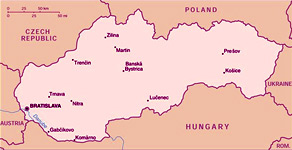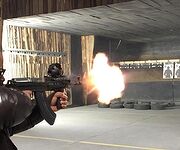Information
Not until 1993 did Slovakia finally emerge as a fully-fledged independent nation, and with it Bratislava as capital. But the leap to sovereignty belies a long and colourful history. Known variously as Wratisslaburgium, Pressburg, Poszony and Istropolis, Bratislava has been a proud player on the European stage for over a millennium.
The location on the northern bank of the Danube has been the defining factor for many centuries. At several points in Europe's history, the river formed a natural border, rendering Bratislava a frontier city. This made for a bittersweet legacy, allowing the city, with its ancient castle, immense strategic importance. But this stature was coveted and Bratislava was invariably vulnerable to attack.
The southern bank of the Danube was traditionally the northern extremity of the Roman Empire. Beyond lay the lands of Free Barbaricum, dominated by the Germanic Marcomanni tribe. These tribesmen were brought to life as a clan of hairy, club-wielding fellows in the film 'The Gladiator', in which Russell Crowe puts them to the sword.
From the 8th to the 10th centuries the area belonged to the Slavic states of Nitra and Great Moravia. But in 907 a defining change occurred in the region when the Hungarians (Magyars) conquered these lands.
By and large, Hungarian sovereignty held sway in the region for some 500 years. It was during this era that the city - called Poszony by the Hungarians - emerged as a significant player on the European stage. The castle was well-fortified, and the city endowed with many privileges.
Disaster struck in Turkish form when the Hungarians were decisively defeated at the Battle of Mohacs (1526). The Hungarian state splintered, and the Bratislava region reemerged as the so-called Kingdom of Hungary. However, the kingdom was effectively a junior partner in the Austrian Habsburg state. Pressburg (Bratislava) was technically the capital of this kingdom, and factions of the Hungarian nobility set up shop here. Habsburg monarchs were crowned in Pressburg as Kings of Hungary all the way up to 1830.
There were several Hungarian uprisings against the Habsburgs over the centuries and the Magyars finally made a breakthrough in 1867, when Austrian Emperor Franz Joseph approved the 'Dual Monarchy'. Hungarian became the dominating culture again in the city, yet a Slovak national movement - Slavonic as opposed to Magyar - had emerged.
After the First World War, the city was absorbed into Czechoslovakia in spite of opposition from the Hungarian and German communities. Bratislava was instated as the official name for the first time. Many from the once dominant Hungarian and German communities emigrated, and Slavic citizens emphatically rose in prominence.
On the eve of the Second World War, Adolf Hitler, having annexed Czech lands, helped create what was largely a puppet state called The Slovak Republic. Bratislava was its capital, but many key players on the international stage refused to acknowledge the validity of the country. The Nazis organised transports of Bratislava's Jews to the camps in occupied Poland and elsewhere.
After the war, a united Czechoslovakia emerged under the shadow of the Red Army as a totalitarian, Communist state. Waves of ethnic Slovaks were settled in Bratislava by the authorities and new blocks built. Following the Prague Spring of 1968, the Communist Party made a largely symbolic split, creating Slovakia as a federal unit in itself. However, it was another 25 years before Bratislava finally became capital of an independent Slovakia. The Iron Curtain collapsed in 1989, following demonstrations in many Central European cities, including Bratislava. Following the Velvet Revolution the Slovaks initiated the 'Velvet Divorce', which allowed them to be a democratic state that was independent of the Czechs. Since then Bratislava has grown steadily more prosperous as the capital of Slovakia, drawing more visitors each year.
 Population: 5.5 million
Capital: Bratislava
Major language: Slovak
Major religion: Christianity
Life expectancy: 70 years (men), 78 years (women)
Monetary unit: 1 koruna = 100 hellers/(halierov)
Main exports: Machinery and transport equipment, foodstuffs, chemicals
Average annual income: US $19,171
Internet domain: .sk
International dialling code: +421
Population: 5.5 million
Capital: Bratislava
Major language: Slovak
Major religion: Christianity
Life expectancy: 70 years (men), 78 years (women)
Monetary unit: 1 koruna = 100 hellers/(halierov)
Main exports: Machinery and transport equipment, foodstuffs, chemicals
Average annual income: US $19,171
Internet domain: .sk
International dialling code: +421
About Bratislava
Slovakia is a landlocked country that is bordered by Poland in the north, Ukraine in the east, Hungary to the south and Austria and the Czech Republic to the west and northwest. It is a touch larger than Switzerland, and like that alpine country, it is predominantly a mountainous region - forty percent of the country is forested. The Carpathian mountain range, which is at its zenith in the High Tatras, forms a natural border along the north of the country.
The territory of present day Slovakia has been ruled over by several powers over the centuries, most significantly Hungary and Austria. Slovaks are Slavs, and the predominant religion is Roman Catholicism. Although the Church was considerably suppressed during the Cold War era, it has made a comeback in recent years. In the east of the country there are historic communities of Ruthenians (Greek Catholics), whose wooden churches add a fine feature to the hilly landscape.
The Slovak national movement took root during the eighteenth century, and the first Slovak newspaper was published in Bratislava (then known as Pressburg) in 1783. Over the next hundred years, several attempts were made to codify the language. The Slovaks often allied themselves with the Czechs in their bids for further rights within the Austro-Hungarian Empire, and this alliance eventually bore fruit in the post First World War state of Czechoslovakia.
The state of Czechoslovakia was broken up by the Second World War, during which Hitler oversaw the formation of a Slovak republic that was a puppet state of the Reich.
Czechoslovakia was reborn after the war, but with little concession to democracy. The Communists took power and any attempt to promote a more liberal agenda was swiftly crushed, most notably in Prague in 1968.
Soon after the Berlin Wall fell Slovakia broke away from the Czechs to form their own nation state (1993). In 2004, Slovakia joined the EU, and the single currency is scheduled to be adopted in 2009.

 GunMates.eu
GunMates.eu
 PAKTA STUDIO
PAKTA STUDIO